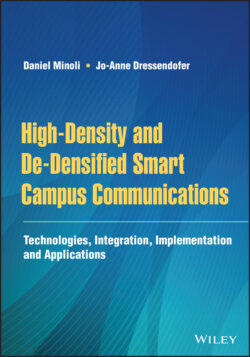Читать книгу High-Density and De-Densified Smart Campus Communications - Daniel Minoli - Страница 19
1.2.4 Pre‐pandemic/Long‐term Requirements for Open Air Gatherings and Amusement Parks
ОглавлениеNetworks for public parks are typically designed around public safety and the availability of cellular service; first responder access is important (e.g. in the context of E911). For data and multimedia services, users will typically utilize their smartphones and 4G/LTE cellular connections; however, in some instances, Wi‐Fi is available, as in the latter case, and is employed to move users toward food and merchandize concessions, or for geo‐fencing applications. A target of one million connections per square kilometer (also definable as 1 connection per m2 or 1 connection every 10 ft2) has been suggested by some researchers [2]. Open air gathering tends to be more “pop up” operations with short‐lived operational timeframes; however, the density could be high, even multiple individuals (say 2–3) every 10 ft2. Requirements include high‐capacity data and video access, and perhaps video surveillance.
TABLE 1.6 Top Amusement Parks in the United States
| Site | 2017 Visitors |
|---|---|
| 1. Magic Kingdom, Lake Buena Vista, Florida | 20 450 000 |
| 2. Disneyland, California | 18 300 000 |
| 3. Disney's Animal Kingdom, Florida | 12,500 000 |
| 4. Epcot, Florida | 12,200 000 |
| 5. Disney's Hollywood Studios, Florida | 10 722 000 |
| 6. Universal Studios, Florida | 10 198 000 |
| 7. Disney California Adventure | 9 574 000 |
| 8. Universal's Islands of Adventure, Florida | 9 549 000 |
| 9. Universal Studios, Hollywood | 9 056 000 |
| 10. Knott's Berry Farm, California | 4 034 000 |
A lower target seems appropriate for amusement parks, given that people go to these parks (usually with high entrance fees) for entertainment and less for spending time on personal communication devices. There are about 430 parks and amusement parks in the United States; Table 1.6 identifies the 10 top parks.
